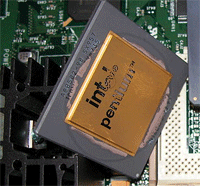Difference Between PowerPC and Intel
 PowerPC vs Intel
PowerPC vs Intel
PowerPC has been working side by side particularly with AppleÃs products for quite a number of years already, but since Apple made a transition to Intel last 2006, it became one of the major influences that made people to compare the two.
PowerPC is a microprocessor developed mainly by the three developing companies Apple, IBM, and Motorola also known as AIM. It is built with reduced instruction-set computer (RISC) which speeds-up the operation of MIPS (million instructions per second). PowerPC is mainly based on IBM’s earlier Power architecture because it has a similar RISC instruction set for microprocessors. They remain compatible with each other though that the same programs and operating systems can run on both. PowerPC versions exist in both 32-bit and 64-bit platform. PowerPC versions such as G4 and G5 can go up to 2.5 GHz clock speed. The PowerPC provides an alternative to IntelÃs popular processors in terms of architecture.
Intel chips have drastically changed over the past fourteen years that loads of Intel family processors have emerged and are highly competitive to other processors. Most of these processors are Nehalem-based. The Intel Core i7 which was first released last 2008 seems to be the fastest so far with maximum clock rate 1.6 GHz ñ 3.47 GHz. Its Quick Path Interconnect (QPI) architecture provides a point-to-point high speed links that allows a much faster communication between the CPU and other various subsystems. Most of Intel Core i7 has 731 million transistors, 4 core and 8MB of L2 cache.
However, if we deliberate on their power consumption, Intel chips seem to consume more power than PowerPC due to the techniques used to raise the performance and clock speeds. While PowerPC is designed and used in an embedded sector, their power consumption is quite lower. Though Intel is a bit higher in speed, their difference in power consumption seems to be 10X greater. For example, if we take a look on their latest versions, the G4 and G5 consumes about less than 10 watts whereas Intel doesnÃt really give out figures rather they only refer to thermal design rating which is around 30 watts or lower than the maximum figure.
One of the reasons why the Apple Company made a transition to Intel is the performance per watt or speed per unit of electrical power provided by Intel. PowerPC probably did not come up with the 3 GHz clock speed requirement of Apple because it wasnÃt available. This requirement was intended by Apple for their laptops or MacBooks which have become the fastest growing segment nowadays.
Summary:
1. Intel chips are undoubtedly faster than PowerPC.
2. Intel maximum clock rate 3.47 vs. PowerPC maximum clock rate 1.6 GHz
3. Intel chips have higher power consumption due to techniques used for higher performance and clock speed.
4. PowerPC is Power-based architecture whose main feature is its reduced instruction set computing (RISC). While Intel processors are mostly Nehalem-based architecture which itÃs main feature is the Quick Path Interconnect (QPI) technology.
- Difference Between EIDE and SATA - February 3, 2010
- Difference Between HTM and HTML - January 27, 2010
- Difference Between Grey and White Matter - January 27, 2010
Search DifferenceBetween.net :
 Email This Post
: If you like this article or our site. Please spread the word. Share it with your friends/family.
Email This Post
: If you like this article or our site. Please spread the word. Share it with your friends/family.


The PowerPC line does not max out at 1.67 GHz. The 7448 and 970MP are available up to 2 GHz.
PPC 970, the G5, officially maxed out at 2.7 Ghz
Hmm, why did G5’s require extreme cooling design if they really do not consume huge amounts of power or generate significantly more heat? Why was there no portable G5 if their power consumption was low? I’ve had couple G5 iMacs and they do run really hot under stress and still they mainly compete with Athlon XP in terms of perfomance, Dual G5 2.0GHz model even lost to a single core Athlon64 when it was benchmarked by one site, can’t remember the name but Google will find it.
All i know is , useing powerpc macs felt way different than intel macs. i know intel is now faster, but something about the power pc chips felt smoother.
idk…
This is the good exemple of article filled with many errors….
IBM has produced Power processors running of 5Ghz…
Freescale produces PowerPC processors with 12 cores, with low power consommation… able to deliver over 300 billions of operations per seconds, far over of what Intel can deliver as computing performance…
But of course, with billions of dollars spent by Intel in marketing, for sure, Intel processors must be the best ones.
Absolutely right, POWER6 is able to run on 5 GHz with nominal cooling techniques, while the intel chips needs water cooling and huge fans at this clock rate.
Not mentioning the instruction set, the x86 core is still the i386 from 1985 but they are still keeps it, to make it able to run winshit.
The G5 is only one of the PPC family. The G4 and earlier models were comparatively low power and cool running processors. Modern ‘Power’ chips generally follow that trend. The 970 ‘G5’ was an attempt by IBM to leapfrog Intel with the first 64 bit consumer PC whilst catching up in the all important MHz war… something that even today blinds people to the truth of how well a processor actually performs. IBM simply didn’t get enough revenue from the desktop PPC market to make further investment worthwhile. Big iron and embedded markets were the real markets for Power CPUs, while Intel and AMD dominated the consumer market, with all the benefits economies of scale bring.